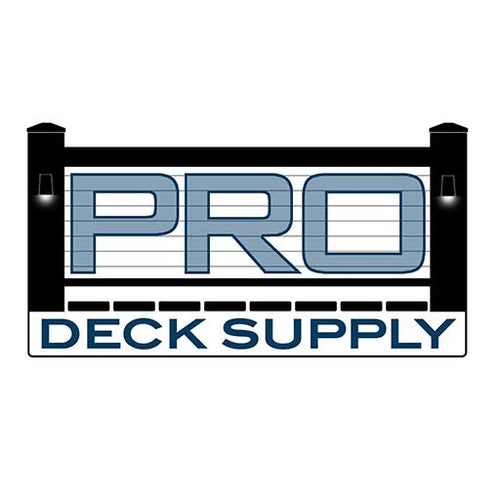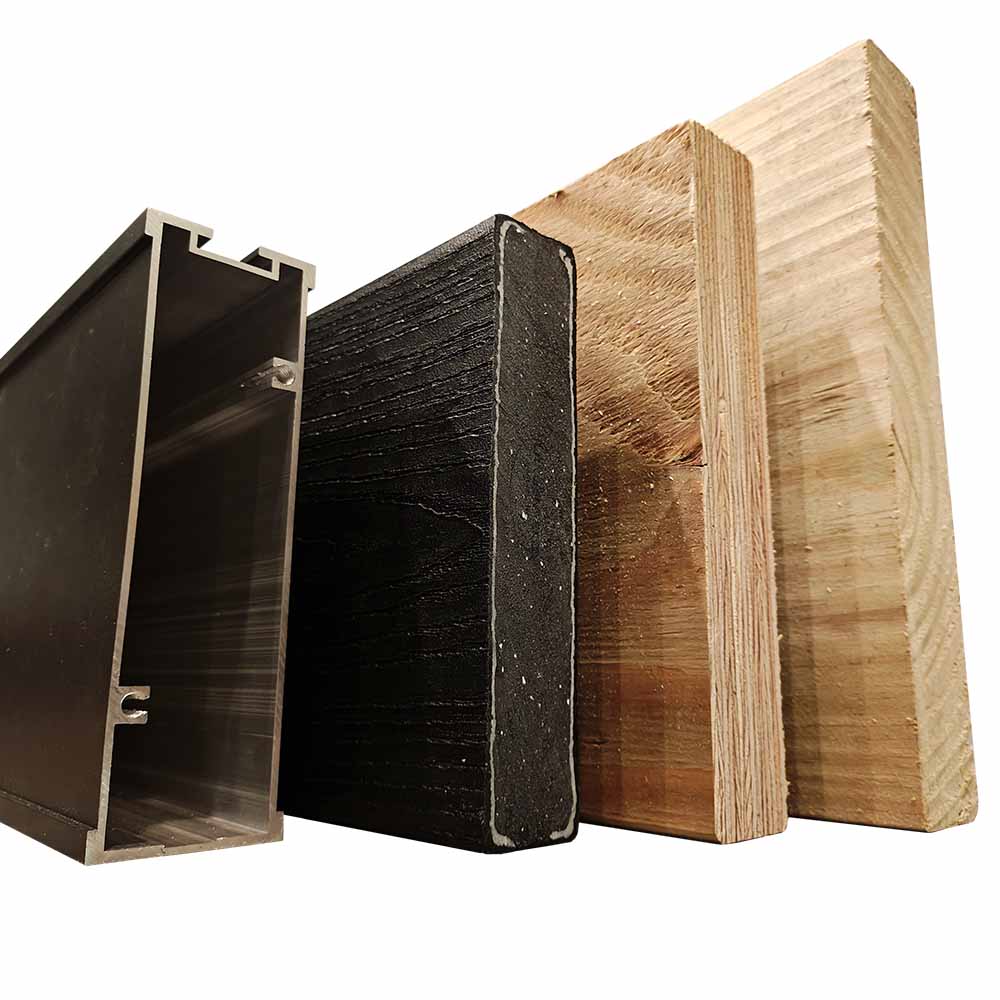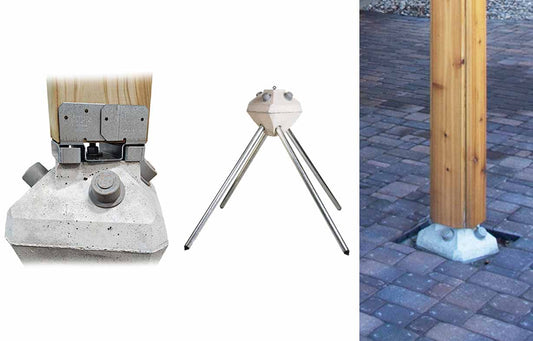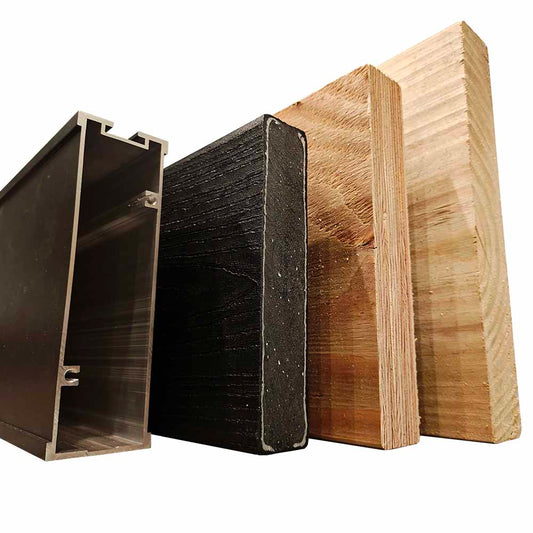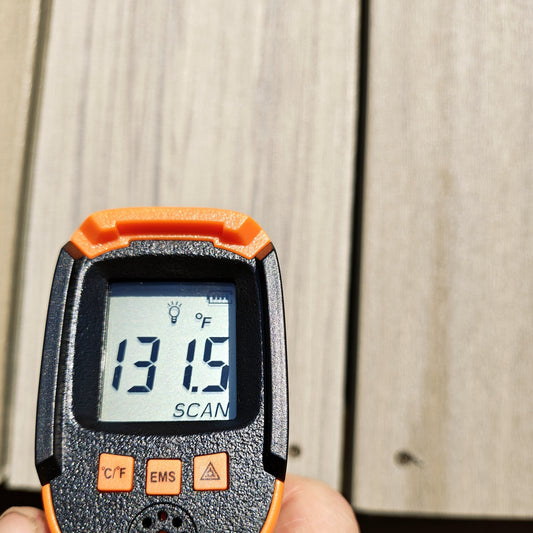Deck framing is the skeleton of your deck, and it's important to choose what's best for you, especially when installing thousands of dollars of decking and railing on it.
It's likely that low-maintenance decking and metal railing will last as long if not longer than your framing material. What's the best choice?
The vast majority of decks are built with #1 or #2 treated Southern Yellow Pine lumber, for its availability, low price, and structural strength. If more stability, span distances, or consistently straighter wood is desired, treated LVL joists and beams are used. If the budget allows for it, metal framing will often be used for a clean appearance and extremely long-lasting frame.

Why Use Treated Southern Pine?
Relatively Low Cost - SYP is harvested from large pine trees, milled to size, and treated to resist rotting. Having readily available raw materials and requiring less processing means a lower price than other factory-produced framing materials. A good quality 2x10 treated SYP joist is usually between $2-3 per linear foot, and is available in lengths usually up to 20 feet long.
Machinability - Wood is one of the easiest materials to cut, drill, and screw into. Most deck construction fasteners by default are designed specifically to work in wood, including specialty fasteners like grooved decking clips. Switching to steel or aluminum usually requires special connectors and fasteners that may cost more or be more difficult to install.
Strength - Southern yellow pine specifically is one of the strongest easy-to-find woods in the US. Treated 2x10 joists of #1 SYP can span nearly 16 feet between supports. Although it is not the strongest choice for deck framing out there, it is used because it's commonly available and meets most folks' needs for deck framing.
Deck Construction
A deck built with 2x10 SYP joists spaced 16" on center, a triple 2x12 flush beam, and only 2 posts could be as large as 14 feet wide and 15 feet out from the house. There are ways to get bigger deck sizes from SYP, but for the sake of comparing against other framing types, we'll use this beam and joist configuration.
Disadvantages of Southern Yellow Pine
Lifespan - Even though it's treated, it's still wood, and it won't last forever. Special attention is needed in areas like ledgers and horizontal blocking where water may get trapped, or where debris like leaves may collect and hold moisture. Since most joists, beams, and ledgers are resting in their edge, it's easy to protect the top surface of the wood with waterproof joist tape, adding more time to its life.
Strength - Southern Pine is strong as far as wood goes, but it can't reach as far as treated LVL or glued laminated lumber will.
Movement - If left to dry before installation, wet treated wood can dry and will then warp or twist. We always recommend installing it as soon as possible after you get it, so that it dries after it's in place. This locks it in place and the framing usually stays in place where it was installed.

Why Use Treated LVL?
Machinability - Laminated veneer lumber is wood that has been cut into layers and glued back together, and it behaves like wood when cutting and screwing it. It requires very little extra consideration beyond wood framing, other than joist tape being a requirement rather than optional.
Availability - Pacific Woodtech is known for their treated LVLs, and they offer sizes ranging from a standard 2x4 profile to a monstrous 5-1/4"x18". Many profiles can easily be changed out for 2x10 or 2x12 equivalent, and your knowledge and hardware can be translated to work with it.
High-strength upgrade from wood - Working with treated LVLs is like working with wood, but you get longer spans out of your beams and joists. And just like wood, multiple plies of 1-1/2" thick material can be set one ply at a time with two guys on ladders, with no crane required (unlike a 6x18 beam might).
As good as metal - Treated LVLs can be configured to have the same or better performance than metal framing, and generally at a lower cost with better availability. LVLs won't require any unique hardware or fasteners, meaning you won't be limited in your decking, fascia, or fastener options.
Cost - Depending on what you compare it to, cost might be a pro or a con. A treated 2x10 costs about a third of what an 1.5"x9.25" LVL would, but the LVL is still about half the cost of metal framing.
Interchangeability - We often combine SYP framing with treated LVL material to maximize the framing capabilities and minimize costs on decks. Usually this looks like treated 2x10 or 2x12 joists and a treated LVL beam, which means fewer deck posts and footings, and a straighter beam.
Deck Construction
A PWT LVL deck built with 1.5"x9.25" joists spaced 16" on center, a triple 1.5"x11.25" flush beam, and only 2 posts could be as large as 16' 8" wide and 17' 8" out from the house. Upsize your beam or joists by a few inches and you can expand a deck even further. Having such long spans means your footings will need to be larger than you might expect, since there are so few bearing points.
Disadvantages
Cost - While not as expensive as metal, LVL is still more expensive than wood. If you have no special structure requirements like clear beam spans or long joist lengths, and can get good quality treated lumber, LVL is often not worth the upgrade. However, this should be balanced against the cost and labor saved on the extra footings that aren't needed.

Why Use Composite Framing?
Weatherability - Owens-Corning's structural composite lumber is one of the few composite non-metal framing systems available, and contains a fully-encapsulating plastic shell around an inorganic filler. It's just as weatherproof as inorganic decking, and can be buried or submerged if needed.
Appearance - OC lumber is mainly available in black, but a large enough order can be special-ordered in other colors. It has a woodgrain texture, and could even be used as decking. We don't recommend the black color for decking though, see our article about hot decking if you're curious why!
Straightness - Composite framing isn't extruded the same way as metal and does come with com variation in flatness, but the 2-by-somethings are going to be straight and true. It will behave much better than wood, but is not going to be as stiff as LVLs or metal joists.
Machinability - The inner layer of the shell is fiberglass, but for the most part, OC lumber can be handled like it's wood. You won't need to order different joist hangers, but a construction screw like a Simpson SD screw should be used in place of hanger nails or beam ply nails.
Deck Construction
A deck built with OC composite 2x10-sized joists spaced 16" on center, a triple 2x12 flush beam, and only 2 posts could be as large as 8'2" wide and 10' 6" out from the house.
Disadvantages of Composite Framing
Cost - A OC composite 2x10 costs about 7 times as much as a treated 2x10. It will certainly last more than 7 times as long, but between that and the appearance, you aren't getting much more for your money.
Wood-like capabilities - What are you getting when you spend 7x as much as wood? A no-maintenance imitation wood that looks fantastic, but isn't any stronger than wood. Owens-Corning's span chart was quite detailed, and nearly too much. From what we can tell, OC structural lumber can't do much more than treated SYP, and definitely not more than a treated LVL.

Why Use Metal Framing?
Weatherability - Metal joists and beams are usually powder-coated aluminum or steel, making them nearly impervious to the elements.
Appearance - Most metal framing is black, and hides well in the shadows beneath the deck, and won't show weathering or grain patterning like treated wood would. It has an elegant look and won't require re-painting.
Straightness - Metal isn't affected by moisture changes, and won't warp or crack like wood does when it dries out. This makes building a level and flat deck much easier, with no need for shimming, trimming, or throwing away bowed material.
Deck Construction
A deck built with Timbertech aluminum 2x8-sized joists spaced 16" on center, a single 2.75"x11.25" flush beam, and only 2 posts could be as large as 6 feet wide and 15 feet out from the house.
Disadvantages of Metal Framing
Cost - A metal joist costs between 4 and 10 times as much as a wood joist, meaning a high cost of entry for a low-maintenance framing option.
Specialized Hardware - Joist hangers, decking and fascia fasteners, and railing mounting parts are unique to each metal system, and cannot be fastened as quickly or easily as wood hangers and screws. Rail posts require through-bolts and mounting plates, joist fasteners require self-drilling metal screws (rather than nails), and decking fasteners need to be self-drilling or built for the framing system.
Machinability - Metal requires special saw blades or even grinding tools to cut it effectively, and there is little room for error on the cut and fitment. If a cut is off-square, it will be much more noticeable and may require a new part, rather than just a shim. When done correctly, the final product looks clean and nearly seamless, but there is extra labor and skill needed to make that happen.
Not as strong as you'd expect - To perform at the level of a treated 2x10 SYP joist, metal framing usually needs more posts and beams. If the space below the deck allows for this, then the only other factors holding you back from upgrading to metal would be the cost and skilled labor.
What would Pro Deck recommend?
Treated pine as the go-to, mix in some LVLs where extra strength is needed. If you have lots of extra room in your budget and have the need or strong preferences, OC lumber would be a sleek and tough upgrade. The project parameters that make metal framing the best and only option are very few, and not something we find the need for very often.
The TLDR
(too long, didn't read)
Treated Southern Yellow Pine is great for most decks, even with its disadvantages.
If you want fewer posts or extra-long joists, LVL is the easiest and best way to make that happen, and can easily be mixed with SYP.
Composite framing has the strength and installation ease of wood, but the cost and clean appearance similar to metal.
Metal framing is expensive and labor-intensive, and besides not rotting and looking nicer, it doesn't offer much more.
